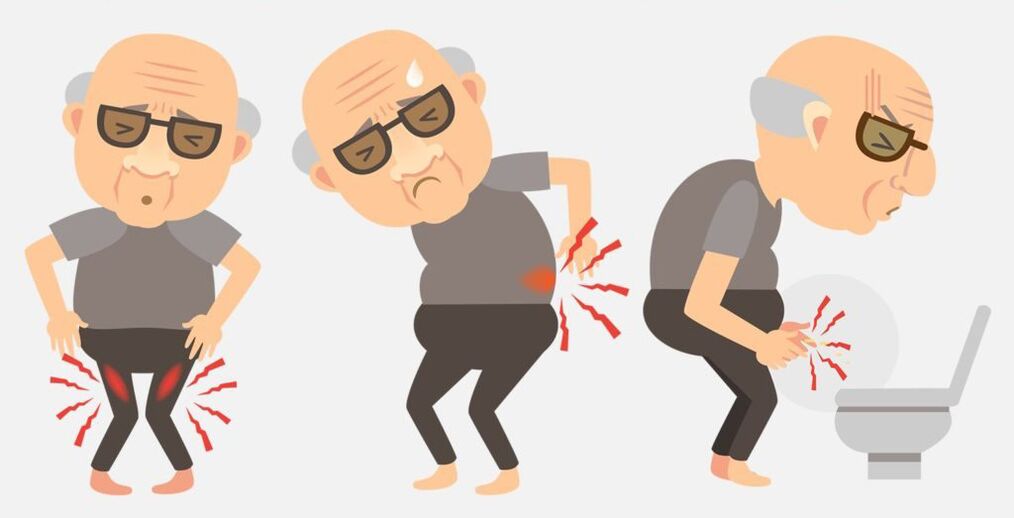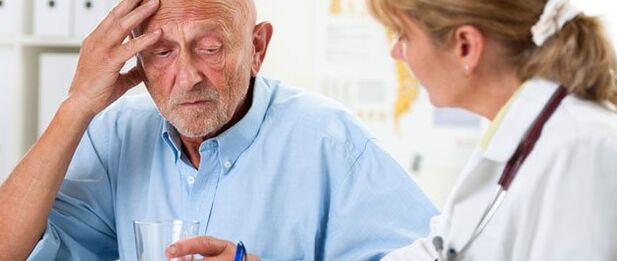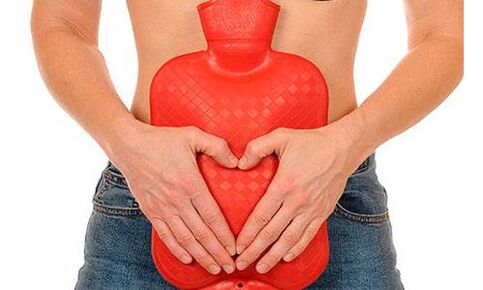In men, the symptoms of prostatitis are not as characteristic and specific as they seem at first glance. Therefore, in modern urology and andrology, infertility is increasingly diagnosed among men of the most active reproductive layer - from 25 to 40 years. In men, the prostate gland is an organ that performs several functions: the barrier, the role of the endocrine, reproductive, copulatory (sexual), bladder sphincter, which regulates blood clotting. In men, the symptoms of prostatitis and its symptoms are multifaceted, especially in the chronic form - they cover all the functions of the body and often make it difficult to diagnose.
Symptoms of acute prostatitis in men

What are the symptoms of prostatitis in men that you should pay attention to them and consult a doctor? Every man, especially at a young and sexually active age, should know about the symptoms of inflammation of the lower genital tract and the possible clinic of primary prostate disease. Many young people postpone a visit to the urologist, thinking that the disease belongs to a larger age group.
Important.
Inflammation of the prostate is based on a complex of factors that begin to fully move at the age of 20-30 years.
- Sexually transmitted infections are the first thing that triggers an active or slow inflammatory process. Chlamydia, mycoplasma infection, gonorrhea, trichomoniasis, gardnerellosis cause urethritis, against which the development of inflammation of the gland is possible. Herpes simplex, human papilloma, CMV viruses, if they do not cause inflammation of the gland, significantly complicate the course of STDs and "lead" to bacteria in the tissues of the body. Against the background of genital infections, opportunistic flora (staphylococci, Escherichia coli) often cause prostate disease. When diagnosed, mixed flora is often detected.
- Prolonged sedentary work is one of the factors that provoke the disease. Such occupational hazards or habits adversely affect prostate health.
- Arrhythmic sex life - whether it is rare or accidental, psychological problems that lead to delayed or no ejaculation, erectile dysfunction, frequent masturbation - significantly disturbs the balance of arterial and venous blood flow in the gland.
- The effects of cold on the lower back, abdomen and extremities - winter sports and rest, occupational hazards associated with hypothermia cause irreversible changes in the tissues of the gland.
Sexually transmitted infections, chronic hypothermia, venous blood stasis and prostate secretions are the basis of chronic prostatitis.. . . Symptoms of prostatitis in different forms are combined into three syndromes: painful, sexual and dysuric (urinary incontinence). The advantage of one of them is a reason to consult a doctor - urologist, sexologist, therapist or surgeon. The vigilance and specialization of the doctor will determine the speed of the recovery process.
Symptoms of acute prostatitis after or at the same time as an active genital infection are characterized by:
- Anxiety and pain when urinating.
- Interruption of urination at the beginning or end.
- Frequent and incorrect call to use the toilet.
- Pain around the anus, especially when sitting.
- Pain during the act of defecation, a feeling of fullness in the rectum.
- Mucopurulent discharge from the urethra.
- Thigh, scrotum, back abdominal pain.
- Temperature.
- Sexual dysfunctions.
Each patient has a different severity of symptoms. Also, only a certain symptom may predominate. However, often the acute process continues with minor symptoms, which often leads to chronicity and an increase in the number of identified cases of chronic prostatitis.
The first signs of prostatitis
Symptoms of the onset of prostatitis in young men occur under the name of acute respiratory infections or in the form of classic genital infections. Depending on the type of pathogen, the symptoms of the acute process may be bright or blurred.
Symptoms of prostatitis in men starting with gonococci, Staphylococcus aureus, Escherichia coli, as well as nosocomial infections (after manipulations in the urinary tract) are characterized by:
- The patient is suddenly caught with a cold that lasts from half an hour to two hours and ends with sweating.
- The temperature rises to 38 - 40 ° C.
- Weakness is characterized by severe weakness.
In men, the first signs of prostatitis may not be accompanied by characteristic pain in the pelvis, rectum and groin.. . . Also sexual weakness is not characteristic. On the contrary, the first stage of catarrhal disease manifests itself with excessive agitation and premature ejaculation.
Important.
Urogenital chlamydia, which often causes chronic prostatitis, initially has only mild dysuric symptoms.
How does prostatitis in men manifest itself when hematogenous or lymphogenic infiltration of the flora into the prostate tissue? This type of disease, which is accompanied by common somatic infectious diseases (sinusitis, sore throat, pneumonia, abscesses, pustular skin diseases), may not be noticed by the patient. Against the background of the underlying disease, the temperature rises again and the symptoms of intoxication increase, mild dysuric episodes and abdominal pain may develop.
Symptoms of chronic prostatitis in men

It combines bacterial or viral, congestive or infectious chronic prostatitis with different symptoms, although inflammatory processes are caused by different triggers, but cause three main manifestations:
- Pain syndrome.
- Disorders of urinary excretion.
- Sexual dysfunction.
Pain symptoms with prostatitis are also divided into three types:
- Extragenital - pain in the rectum, lower back, abdomen.
- Pelvic - symptoms of pain do not appear, but there is itching of the anus, tingling, paresthesia, neurosis, excessive sweating - this is due to the involvement of the pelvic nerve plexuses in the process.
- Genital - pain in the testicles, lumbago in the testicles, groin and perineum.
- Mixed.
Pain symptoms in prostatitis form a concept such as "chronic pelvic pain syndrome in men. "
Symptoms of chronic inflammation of the prostate gland are accompanied by erectile dysfunction and suppression, ejaculation and decreased libido. Against this background, there is a persistent neurosis-like syndrome of sympathetic or parasympathetic type. The first is characterized by palpitations, fever, evening subfebrile condition, sudden mood swings, inattention attacks. For the second - drowsiness during the day, fatigue, insomnia at night, hypochondria, sweating, weight gain, swelling in the throat, excessive salivation.
Dysuric events include increased urination, difficulty emptying the bladder, dripping, and lethargy. Such symptoms have a clear resemblance to an adenoma, which sometimes complicates the diagnosis.
Important.
In men over the age of 45, chronic prostatitis often occurs at the same time as prostate hyperplasia.
Chronic spermatorrhea and prostatorea are the secretion of prostate secretions from the urethra along with seminal fluid due to organ atony.
Symptomatic prostatitis
Inflammation of the prostate is not always symptomatic. Often a man, for example, learns about a disease while conducting an ultrasound diagnosis while planning a child. They detect calcifications in the tissues of the prostate gland, obliterated ducts, enlargement or reduction of the gland, sclerosis, impaired blood flow due to Doppler, varicose enlargement of the prostate plexus and small pelvic vessels.
Symptomatic prostatitis develops in young men after exposure to genital infections, especially urogenital chlamydia and mycoplasmosis.Asymptomatic prostatitis is especially common after inadequate and incomplete treatment of these diseases. Examination of sperm often reveals a decrease in the number of germ cells, a decrease in active cells, agglutination, and a decrease in lecithin grains. Periodic sexual failures that the man does not care about are possible.

Symptoms of prostatitis exacerbation
Exacerbation of chronic prostatitis develops when exposed to negative stimuli - general somatic diseases, hypothermia, irregular sexual activity, alcohol abuse, exacerbation of infectious diseases of the genitourinary organs, rectum.
In men, the symptoms of prostatitis exacerbation are similar to the onset of the disease. Rising temperature, general malaise, fatigue, weakness, tremors come to the fore. Pain in the anus, fullness in the rectum, lumbago in the groin, enlarged perineum. Sexual dysfunction and irritability also worsen. When going to the toilet, patients report difficulty and increased urination, decreased flow, and pain.
Features of the course of some types of prostatitis
How do prostatitis manifest itself in different types in men? Conventionally, several types of disease differ depending on the predominant process: infectious, bacterial, stagnant, purulent.
Infectious and bacterial prostatitis
The concept includes several nosological forms of the disease, or rather differentiates them according to the type of pathogen. Symptoms can only begin with sexually transmitted and opportunistic pathogenic flora of infectious prostatitis, which can be caused by pathogenic bacteria and viruses. Conventional pathogenic microorganisms that normally live in the male genitourinary system cause disease only with unfavorable factors. Escherichia coli, staphylococcus, and enterococci are often found when sperm and urine are sown. This is bacterial prostatitis.
Infectious prostatitis is mainly registered among young people.This type of inflammation of the prostate gland is the most chronic and causes infertility.
The clinical picture is characterized by the greatest brightness with gonorrhea and few symptoms with chlamydia, mycoplasmosis and opportunistic pathogens, so it often causes chronic prostatitis.

Purulent prostatitis
Pyogenic flora is represented by gonococci, Pseudomonas aeruginosa, Escherichia coli, methicillin-resistant strains of Staphylococcus. These microorganisms secrete a number of destructive enzymes, are characterized by aggression against the tissues of the prostate gland, and therefore begin a purulent association.Often purulent prostatitis ends with abscess, phlegmon, paraprostatitis, paraproctitis.
The purulent process is often started by bacteria that enter the prostate gland in the following ways:
- From purulent foci in other organs.
- For medical interventions on the genitourinary system. The hospital flora is characterized by high resistance to antibiotics and therefore causes purulent prostatitis.
Purulent prostatitis, whose symptoms are most noticeable, often leads to complications: urinary and vesicular-intestinal fistulas. Also, such bacteria easily penetrate the ascending pathways to the kidneys, pelvis, and calyx, causing their chronic inflammation.
Congestive prostatitis
An isolated course of this type of disease is practically excluded, because against the background of stagnant processes, the microbial flora closes and takes the infectious form of this type of course. Urologists often make such a diagnosis when no bacteria have been isolated during the inoculation of the biomaterial. As a rule, the analysis carried out after 2-3 weeks will already give a positive result for the bacterial flora.
Venous blood stasis is often accompanied by varicose veins, rectal pathology, pelvic tumors, hypodynamics. Impaired prostate secretion, which is most common in sexual dysfunctions and irregular sexual activity, leads to stagnation and the initial conditions of inflammation.Congestive prostatitis, the symptoms of which coincide with infectious inflammation, are inextricably linked and follow each other.Symptoms will be complemented by varicose veins and rectal lesions.
It is clear that the manifestations in the chronic form of prostatitis may be non-specific, which requires a thorough diagnosis.
Important.
Any sign of a genital infection in a man should lead to contacting a urologist or venereologist for treatment.
Self-medication or neglect of the condition can lead to the formation of a chronic form.
























